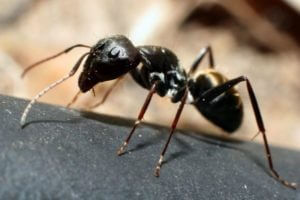
Sugar Ant Control: Protect Your Home or Business
Facts
- What are sugar ants? The term “sugar ants” actually refers to more than one species. Types that exist in the Mid-Atlantic region include pharaoh ants, odorous house ants, and pavement ants.
- Why do I have sugar ants in my kitchen? These insects prefer to eat sweets, as well as fatty, greasy, or high protein items like butter or bacon. Even things like used bandages attract some sugar ants, causing trouble in places such as hospitals or nursing facilities.
- What’s up with sugar ants? These pests communicate with one another through chemicals called pheromones. They use these to mark the trail from their homes to food sources. The greater the number of ants that visit that spot, the stronger this invisible path becomes.
- Do sugar ants bite? They CAN but they rarely do. They don’t have stingers, but if they feel especially threatened they can use their mouth parts to bite. The bite is painless and really just more for a show of aggression.
Appearance
Adult sugar ants range from one-sixteenth to one-eighth of an inch. Their eggs and larvae are tiny, so it’s unlikely that you’ll see them. Ranging in color from reddish-brown to black, a sugar ant’s body consists of a head, thorax, and abdomen. They also have a set of antennae and three pairs of legs.
Every nest houses several kinds of sugar ants that have different roles. Workers are on the smaller side, and you’re most likely to see them on the floor near walls and crevices. Winged ants are about twice this size, and they serve to reproduce and protect nests. Once a queen mates, she loses her wings and lays eggs for the rest of her life.
How Do Sugar Ants Get Inside Buildings?
Sugar ants are so small that sugar ants in your house is almost inevitable. They can enter through fractures in brickwork or foundations, narrow openings around thresholds, or utility connections. Food is the main motivator for these pests, so pet bowls, crumbs, and unsealed containers may attract them to your home. Sugar ants in the kitchen are a common site.
In commercial settings like hotels and cafeterias, sugar ants can come in on trash cans or around chutes that connect to dumpsters. Businesses that send and receive frequent deliveries, such as food processing plants or warehouses, might end up with a sugar ant problem due to the open doors and loading docks.
Signs of Sugar Ant Infestation
- Trails – You will likely see sugar ants traveling to and from locations like office break rooms and waste bins.
- Dirt – Sugar ants will disturb earth and other materials when building a nest. Look for piles of debris near baseboards or cracks in sidewalks.
- Flight – During mating season, you may notice swarms of these winged insects flying outdoors, or gathered near windows trying to get outside.
- Food – Food often draws sugar ants in large numbers. Restaurants, grocery stores, and kitchens are prime targets for an easy meal.
Problems Caused by Sugar Ants
Around homes, sugar ants can cause structural damage to patios or sidewalks when creating their nests. They may also contaminate stored goods or produce as they feed. Although mostly a nuisance, one type of sugar ant, the pavement ant, may attempt to sting. Their stingers, however, are usually too weak to pierce human skin.
Other places where snacks or crumbs are common, like theaters, dorms, or daycares, can experience sugar ant infestations. Medical practices, in particular, need to be cautious about these pests because of their interest in soiled bandages and wounds. Sugar ants may potentially carry infectious bacteria like Clostridium, Staphylococcus, and Salmonella.
Prevention Tips
There are several things you can do to avoid having a sugar ant issue. First, get rid of any potential food or water sources by fixing leaks and cleaning up any spills or messes. If you see sugar ants, it’s important to wipe up the area to remove their pheromone trails. Cleaning up and removing things that attract them is a great way to get rid of sugar ants.
You should also seal off any cracks or gaps a sugar ant could use to move indoors. Although it might seem tempting, you shouldn’t spray these areas yourself. It could cause sugar ants to scatter and form new colonies rather than make them go away. If you’re looking to kill sugar ants, instead, contact the professionals at Western Pest Services to take care of the problem.